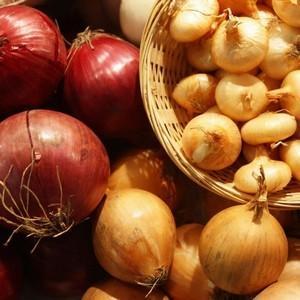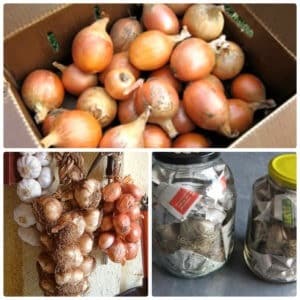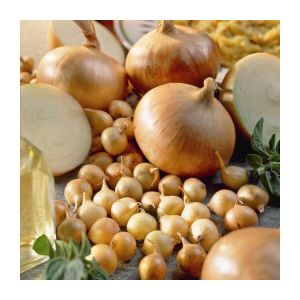Step-by-step instructions on how to preserve onions for the winter at home
Onions are a necessary ingredient for preparing many first and second courses, salads, and winter preparations. After harvesting, the question arises of how to preserve this vegetable until the next season. To keep the product fresh and edible for several months, you should follow a number of recommendations.
Basic rules for storing onions
A dry, cool and dark place with good ventilation is ideal for storing onions.
Required temperature conditions

Recommended storage temperature is 0…+3°С. In such conditions, it is possible to preserve the beneficial properties of the vegetable crop as much as possible. When storing warmly in an apartment, maintain the temperature around +18°C.
Humidity level for storing onions in an apartment
When choosing a place for onions, do not forget that excess moisture has a negative effect on the bulbs, as a result of which they rot and become moldy. The optimal humidity level for storage in an apartment is about 70%.
Shelf life
If you follow the recommendations for storing onions, then in the apartment the product remains suitable for consumption, does not lose its presentation, and retains its taste and beneficial qualities for 8 months. If onions are stored in cellar or basement, the shelf life can reach a year.
Varieties suitable for long-term storage
The good keeping quality of fruits is largely determined by the variety, so it is important to choose it correctly.
In this regard, the following varieties are most popular among gardeners:
- Bastion. Representative of mid-season varieties. The bulb is flat-round in shape with dry and dense scales. It is grown in all regions of Russia, with the exception of the southern ones. Has excellent taste. Can be stored for at least 9 months.

- Stuttgarter Riesen. Bred in Germany. Early ripening variety. It has a large bulb, about 150 g. It produces a high yield. Does not require maintenance. Well kept.
- Orion. A variety obtained by English breeders. It is an early-ripening species, so it is often grown in regions with short summers. The fruit reaches a weight of 200 g and is well stored.
- Yalta. The bulbs are purple in color and flattened in shape. They have juiciness and excellent taste. Due to its sweet taste, it is often consumed raw.
- Arzamas. Well suited for growing in midland conditions. The bulbs have a round shape and a pungent taste. The variety produces a high yield, is resistant to pests and has a long shelf life.
- Red Baron. Representative of early ripening varieties. The fruits are red, weighing up to 80 g. Onions have a dense structure and are considered one of the best varieties for winter storage.
- Hercules. Belongs to mid-early varieties. The fruit is large and round. It is resistant to high temperatures and drought.
- Bessonovsky. Has a pungent taste. 4-5 bulbs weighing 40-50 g grow in the nest. The flesh is dense, yellow or white. Onions contain a large amount of dry matter, which helps vegetables last longer.
Preparing onions for long-term storage
The harvested onion crop is dried for 10-15 days in the fresh air. The bulbs are laid out in one layer on a dry surface. To do this, use wooden flooring or a blanket.
If drying is carried out in an apartment, then place the onions in a well-ventilated place (balcony) or use an oven to dry. It is first heated, and then turned off and the bulbs are placed in it.
Attention! Make sure the onion doesn't dry out. A sign of this condition is cracked scales.
After drying, dry feathers are trimmed, leaving the necks about 4 cm long. The top layer of scales is also removed.
Reference! For onions grown in humid climates with constant rainfall, it is recommended to remove almost all of the scales. It forms again during storage.
How to store onions at home: suitable containers
To store onions, select the necessary containers. Most often used:
- Wicker baskets. They are well ventilated (one of the most important storage conditions) and aesthetically pleasing. This container is suitable for a small amount of vegetables.

- Wooden boxes. They are practical to use, as they take up a small area when placed one on top of the other. Provide good ventilation.
- Cardboard boxes. The material has high breathability. You can additionally make small holes in the walls. Cardboard packaging from household appliances and shoes is often used as containers for onions.
- Ordinary bag. To prevent the product from deteriorating, it is recommended not to fill it more than 30-40 cm. Although burlap has excellent air permeability, air circulation is disrupted in an overfilled bag. This storage option is not very aesthetically pleasing, so it is used for basements and storage rooms.
- Onion braid. Onion wicker is not only a great way to store, but also a decorative element that will decorate the kitchen.The storage method is effective since there is no air stagnation. It is also possible to visually monitor the condition of the bow.
In a refrigerator
Housewives often store onions in the freezer.
The vegetable is prepared according to the following scheme:
- cleaned of scales;
- cut into slices or half rings;
- frozen on a board;
- placed in a special plastic bag for food products and placed in the freezer.
This method will help preserve only a small amount of onions.
In nylon tights and stockings
Nylon is a thin synthetic fabric that is highly breathable. Nylon tights can be safely used as containers without worrying about air exchange. This storage option is suitable for the basement and pantry.
Storage methods in cellars and warehouses
Cold storage uses shelves and racks. Onions are also placed in vegetable boxes. Spread in a layer of about 40-50 cm to prevent it from rotting. The containers are placed on shelves or special stands so that the bottom does not come into contact with the floor.
Onions are also placed in small bags.
Attention! Cellophane bags are not suitable, as vegetables quickly deteriorate in them.
If you have a large number of egg containers available, they make great storage containers. Place an onion in each cavity and place it on a shelf or rack.
Make sure that the ventilation in the cellar works well. If the room is damp and poorly ventilated, the bulbs will quickly sprout and become unsuitable for eating.
When the room temperature drops slightly, the hot onions are not damaged. Sweet varieties are frost-resistant.
When storing in the cellar, constantly monitor the condition of the bulbs.If moisture appears on them, they should be dried and the storage should be well ventilated.
Advice. Lime will help remove excess moisture. It is poured into containers and placed in the corners of the cellar.
About the storage features of some types of onions
Storing certain types of vegetables has its own characteristics.
How to store green onions
Green feathers can be placed on the bottom shelf of the refrigerator. There the product is stored for 10-14 days.
To ensure that the greens remain fresh for a long time and do not spoil or wither, the roots are moistened with water and wrapped in a wet cloth. Then they place it in a paper envelope and bandage it so that the moisture evaporates less.
Green feathers are also wrapped in food paper and placed in a bowl with water, and covered with a bag on top.
Green onions keep well in dried form. Dry both in the open air and in the oven.
How to store leeks

In the cellar, leek bulbs remain suitable for consumption for six months, while they retain all their beneficial and tasteful qualities.
Before storage, the roots are cut to a length of 3 cm and yellowed leaves are removed. In the basement, leeks are placed in containers with wet river sand. The bulbs are placed in a vertical position with a slight tilt, and the roots are buried in a layer of sand about 10 cm.
Vegetable crops are also frozen or dried.
Attention! You can also store onions on the balcony. Containers with the product are insulated with old outerwear or a blanket.
Onion sets
The favorable temperature regime for sowing is up to +16°C, so it is stored in an apartment in a cooler and drier place. Small bags and cardboard boxes are used as packaging.
A basement or cellar with good ventilation is suitable for storing seedlings.
Reasons for onion spoilage during storage
Product spoilage often occurs due to disease infection:
- bacterial rot;
- fusarium;
- cervical rot.
Bacterial rot is clearly visible on the cut of the bulb. Healthy scales alternate with yellowed ones. The fruits emit an unpleasant odor.
Cervical rot develops slowly and can be difficult to detect.
When infected with fusarium, the onion begins to deteriorate from the bottom and becomes soft and watery.
The following factors also contribute to rotting:
- wrong choice of variety;
- Damage to bulbs during harvest.
Onions quickly become unsuitable for food if the temperature and recommended humidity are not observed.
Problems during storage
Other difficulties may arise when storing the product. In apartment conditions, onion flies appear. This is facilitated by damaged and rotten fruits, which create a favorable environment for the reproduction and feeding of the fly. Check your onions regularly and thoroughly to remove damaged specimens in a timely manner.
If a vegetable is stored in violation of the recommended humidity, it begins to sprout. To prevent this, onion heads are sprinkled with dry peels or chalk powder. For 10 kg of onions, use 250 g of the product.
Useful tips

To successfully preserve onions until the new harvest, Experienced farmers recommend adhering to the following preventive measures:
- regularly change the site for planting vegetables;
- carry out disinfection treatment of planting material;
- disinfect the soil with special means before planting;
- observe agricultural technology for growing vegetables;
- carefully clean and sort the harvested crops;
- dry it well.
Be sure to ensure good air circulation in the area where the product will be stored.
Conclusion
The process of storing onions requires compliance with certain conditions. In order for the onions to last until the next season and maintain their presentation, you must follow the recommendations of experts, regularly sorting out the bulbs and removing damaged and spoiled ones.